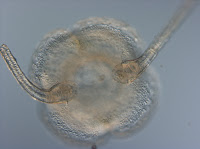This is a picture of an unusual hydrozoan larva, a two-tentacled actinula of the narcomedusa Solmundella (Woltereck 1905). We found several of these in a near-surface plankton sample taken about 2 miles off shore and 5 miles south of the mouth of Coos Bay, Oregon on December 9, 2011. The anterior of the actinula larva (to the right on these pictures) is somewhat pointed, the posterior may be rounded, truncated or bell-shaped. The arms are solid and supported by what looks like a single row of neatly stacked clear endodermal cells.
These larvae can retract their arms, so they look like short bumps (left), or stretch them out so they are several times the body length (not shown). They can also flex their arms, so they are pointed forward, spread out like a "T", or folded back.
One of these larvae metamorphosed overnight into a young medusa (shown on the left). The medusa of Solmundella has only two tentacles, which arise from the bell, rather then its margin. Narcomedusae are part of the order Trachylina (class Hydrozoa), which characteristically lacks polyp generation. As you can see here, the larva of Solmundella directly develops into a medusa, so a benthic stage is lacking from the life cycle entirely. In other Hydrozoans (e.g. order Hydroida) the larva (typically, non-tentaculate planula) settles and develops into a benthic polyp, which may form a colony of interconnected zooids and bud off medusae (which develop gonads, and release eggs, which develop into planulae, and so on). See a post by Ashley Choi on the life cycle of the hydrozoan Obelia - which includes both the polyp and the medusa generations.
Woltereck, R. 1905. Entwicklung der Narcomedusen. Deut. Zool. Gesell. Verhandl. 15.
Friday, April 6, 2012
Subscribe to:
Post Comments (Atom)






No comments:
Post a Comment